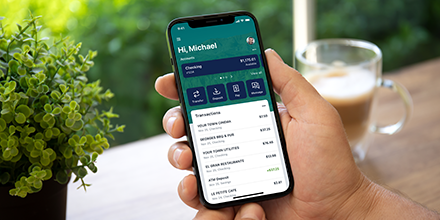
Begin Your Child's Financial Journey
Set the foundation for your child with one of our youth account options.
Whether you’re starting an account for your newborn, or your teen, we’ve got you covered.
Whether you’re starting an account for your newborn, or your teen, we’ve got you covered.
Teach the Importance of Savings With A Youth Savings Account
 Saving for college, a first car, or a trip to the amusement park? Help your child prepare for all their lofty goals with a Youth Savings account. There is no monthly service fee and the minimum balance to open is $25. Students in grades 1 through 12 are eligible to participate in our Earn While You Learn Program.
Saving for college, a first car, or a trip to the amusement park? Help your child prepare for all their lofty goals with a Youth Savings account. There is no monthly service fee and the minimum balance to open is $25. Students in grades 1 through 12 are eligible to participate in our Earn While You Learn Program.- Pays $2 directly into an open Youth Savings account for every “A” (or top grade1) the student received on their end-of-year report card.
- Maximum payout of $50 per student, per school year.
- End-of-Year report cards are accepted during the months of June, July or August.
- Report cards can be brought into a local Community Bank location, or they can be submitted through a message in Digital Banking.
Visit your local Community Bank location to open a Youth Savings Account.
Begin Developing Financial Habits With A Simply Checking Account
Empower your child with real-world financial tools. This account allows your child to have a debit card and learn how to track their spending habits without any overdraft fees.
Our Simply Checking account service fee is waived for primary account owners under the age of 232.
Visit your local Community Bank location to open a Simply Checking Account.

Monitor Debit Card Usage
Experience complete control over your child's debit card with the Card Valet app. Establish spending limits, limit transactions to set geographic areas or store types.

Track Your Child's Spending
Connect your Child's account to a Digital Banking profile to track spending in real-time.

Teach Financial Literacy
Our online simulation provides real-world scenarios to help promote healthy spending habits.
1. Top grades include any grade of an “A” (A+, A-, A). Top grades should be noted on report card, such as “E” for excellent or any other grade/number as indicated on the report card. Bonus is paid once per main school subject per grading period. If no final grade is given for a main category, grades will be averaged from subcategories to determine final grade.
2. Once the primary account owner reaches the age of 23, age can no longer be used to avoid the monthly service fee. Customers under the age of 18 must have an adult co-owner.
